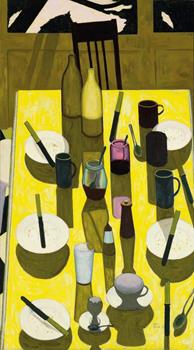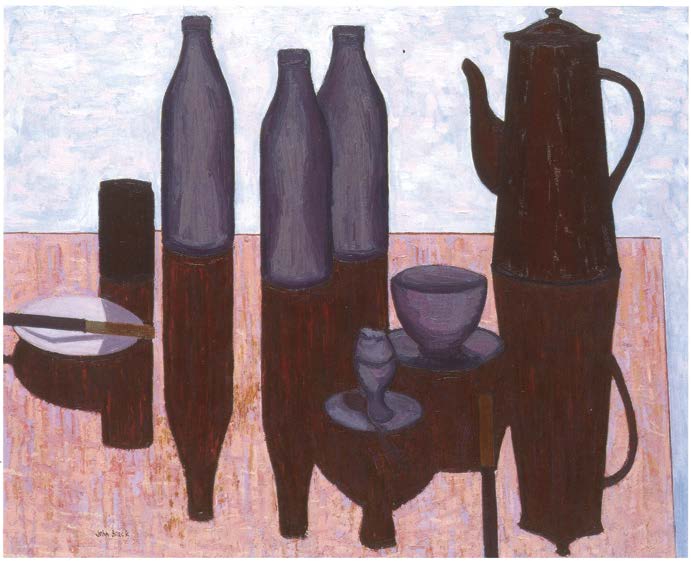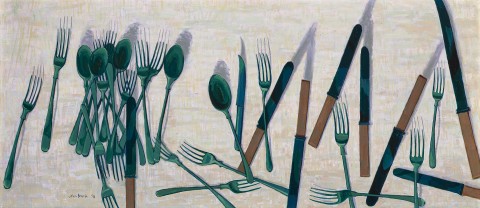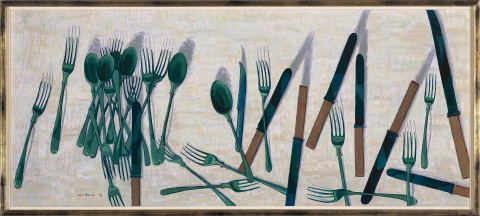KNIVES AND FORKS, 1958
JOHN BRACK
oil on canvas
41.5 x 99.0 cm
signed and dated lower left: John Brack 58
inscribed with name and title on gallery label verso: KNIVES AND FORKS
Australian Galleries, Melbourne
S.D. Hillas Pty Ltd, Melbourne, acquired from the above
Geoffrey Hillas, Melbourne
Deutscher Fine Art, Melbourne
Private collection, Sydney, acquired from the above on 27 April 1992
Second Anniversary Exhibition, Australian Galleries, Melbourne, June 1958, cat. 14 (label attached verso)
Helena Rubenstein Travelling Art Scholarship, Art Gallery of New South Wales, Sydney, 5 August 1958
Australian Painting: Colonial, Impressionist, Contemporary, Art Gallery of South Australia, Adelaide, 17 – 31 March 1962; Tate, London, 24 January - 3 March 1963; National Gallery, Ottawa, April - May 1963
John Brack: A Retrospective Exhibition, National Gallery of Victoria, Melbourne, 10 December 1987 – 31 January 1988, cat. 39
A Selection of Nineteenth and Twentieth Century Australian Art, Deutscher Fine Art, Melbourne, 8 –24 October 1992, cat. 70 (illus. in exhibition catalogue)
John Brack Selected Paintings 1950s to 1990s, Geelong Art Gallery, Victoria, 15 June – 14 July 1996, cat. 5
John Brack Retrospective, The Ian Potter Centre: NGV Australia, 24 April – 9 August 2009 and touring to The Art Gallery of South Australia, Adelaide, 2 October 2009 – 31 January 2010 (label attached verso)
The Art Critic, ‘Striking Exhibition of Powerful Works’, Sydney Morning Herald, Sydney, 5 August 1958, p. 2
Bonython, K., Modern Australian Painting & Sculpture: A Survey of Australian Art from 1950 to 1960, The Griffin Press, Adelaide, 1960, p. 42 (illus.)
Turnbull, C., Young, E., Thomas, D., Australian Painting: Colonial Impressionist Contemporary, Griffin Press, Victoria, 1962, p. 41
Hoff, U., ‘John Brack’, Art and Australia, Ure Smith, Sydney, vol. 2, no. 4, March 1965, p. 279 (as ‘Knives and Forks, 1957’)
Miller, R., John Brack, Lansdowne Australian Art Library, Melbourne, 1971, Illus. 2, pp. 9, 20, 22 (illus.), 107
Catalano, G., ‘Local subjects bear universal concerns’, The Age, Melbourne, 16 December 1987, p. 14
Grishin, S., The Art of John Brack, Oxford University Press, Melbourne, 1990, vol. I, pl. 12, pp. 70, 71 (illus.); vol. II, cat. o79, pp. 188 - 89, 192
220472.jpg

Interviewed by Robert Hughes in 1959, John Brack declared, ‘National style is a thing of the past… I couldn’t care less about Australian Myths and Legends. I suppose bushrangers are very beautiful, but they bore me’.1 Emphasising his perspective on the type of subject matter that was relevant to a local, contemporary audience, Brack continued, ‘there’s only one true sort of Australian painting… and it consists of truthfully reflecting the life we see about us.’2
As a painter of modern life, Brack found the subjects of his art in his immediate surroundings, the suburbs and the city of Melbourne. His best-known paintings of 1950s Australia, such as The New House, 1953 (Art Gallery of New South Wales) and the iconic Collins St, 5p.m., 1955 (National Gallery of Victoria), are full of acute observations of contemporary living, seemingly humorous and ironic – and from an early twenty-first century perspective, definitely also nostalgic. Such images were primarily motivated however, by Brack’s intense interest in people and the human condition. His early resolution to produce an essentially humanist art that engaged directly with the present was supported by his reading of authors including Rainer Maria Rilke, who advised to ‘seek those [themes] which your own everyday life offers you’ and Henry James, who found inspiration for his stories in random events and snippets of overheard conversations.3 As Brack explained, ‘I believed … that you had to decide whether you were going to… take no notice of events or whether you were going to be engaged. Temperamentally, it was obvious I had to be the latter.’4
Brack’s practice of identifying subject matter that was close at hand inevitably resulted in images with a distinctly local flavour – recognisable to anyone who grew up in mid-twentieth century Australia, and especially in Melbourne – and unavoidable elements of autobiography appear throughout his oeuvre. The artist’s family inevitably features, his wife Helen was the model for The Sewing Machine, 1955 (Art Gallery of Ballarat) for example, and their daughters provided both the visual and thematic inspiration for paintings like The Chase, 1959 (private collection). Similarly, The Bar, 1954 (National Gallery of Victoria) – an homage of sorts, which transposes the Parisian setting of Edouard Manet’s famous painting, A Bar at the Folies-Bergère, 1882, to austere 1950s Melbourne – was based on Brack’s experience of the six o’clock swill in city pubs on his way home from work.
Alongside such references to significant historical works of art, Brack also worked within traditional categories of Western art including portraiture, the nude and still-life. During the late 1950s, he addressed the still-life genre, depicting cut flowers in vases – carnations, gerberas and solandra, just as you might find them in a mid-century suburban home – as well as focussing on other everyday domestic items, which he isolated and described in his characteristically cool and analytical style. If The hairbrush, 1955 (private collection) represents the ritualised, daily activities of the bathroom, the kitchen and the busy family life that revolves around it is symbolised by a small group of still-life paintings from 1958 which focus on cutlery and crockery.5 In The Breakfast Table, 1958 (Art Gallery of New South Wales) for example, we see the remnants of a family’s morning meal, an arrangement – seemingly haphazard, although knowing Brack, anything but – of plates sprinkled with toast crumbs, an egg cup, jars of jam, bottles, glasses and mugs. A series of knives adds to the rhythmic pattern of the image, their varied angles echoing the rotating hands of a clock and, alongside the deep shadows cast across the table by the rising sun, reminding us of the passing of time and the human activity which preceded this scene.
DH2022 ART Cat (May 2022) FA3.jpg

The closely related painting offered here, Knives and forks, 1958 depicts knives of various kinds, forks and spoons laid out randomly across a flat surface. In the absence of pictorial detail to provide context, it appears as if the contents of a cutlery drawer have been emptied on to a table and one can imagine Brack gathering props from the kitchen and doing just that, or at least recreating an artful simulation of that. The horizontal format of the picture encourages a left to right reading, the dense conglomeration of cutlery on the left-hand side opening up into a more regular arrangement interspersed with bone-handled knives and concluding on the far right with a large carving knife. The background comprises brushstrokes of pale green and lilac – classic colours of 1950s domestic interiors – while the cutlery creates muted grey shadows which contribute to the delicacy and visual complexity of the image.
This painting fits neatly into Brack’s work of the time, however it also points to the shop window paintings of the early 1960s, such as Still life with self-portrait (Art Gallery of South Australia) and The scissors shop (private collection), both 1963, where the display of multiple implements, the patterns they create and the meanings they imply, comes into focus. Knives and forks is an even more direct precursor however, to the ‘Unstill Life Series’ of the mid-1970s which heralded a major shift in Brack’s imagery and approach. Eschewing the figure and the social commentary this subject enabled in favour of familiar, everyday subjects – cutlery, postcards, playing cards, umbrellas and pencils, for example – Brack shifted his view from the local to the universal, now seeking to present ‘a new visual metaphor that would permit him to express the whole complexity of social interconnections’.6 As Patrick McCaughey astutely observed, ‘The still life enables him to ruminate and reflect on ideas and arguments beyond the scope of observed experience. Brack becomes a ‘modern history painter’, able to take on the largest speculations pictorially through the humble genre of the studio still life.’7
1. Brack quoted in Hughes, R., ‘Brack: Anti-Romantic Gad-Fly’ in The Observer, 21 March 1959, p. 182
2. Ibid.
3. See Grant, K., ‘Human Nature: The Art of John Brack’ in Grant, K., John Brack, exhibition catalogue, National Gallery of Victoria, Melbourne, 2009, p. 92
4. Brack, J., ‘Brack on Brack’, Council of Adult Education, Discussion Group Art Notes, Melbourne, ref. no. A401, 1957, p. 1
5. Also relevant here is Breakfast still life, 1958, oil on composition board, approx. 63.4 x 73.6 cm (private collection)
6. Grishin, S., The Art of John Brack, vol. 1, Oxford University Press, Melbourne, 1990, p. 140
7. McCaughey, P., ‘The Complexity of John Brack’ in Lindsay, R., John Brack: A Retrospective Exhibition, National Gallery of Victoria, Melbourne, 1987, p. 9
KIRSTY GRANT

